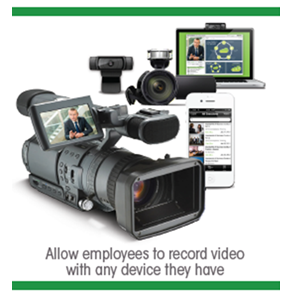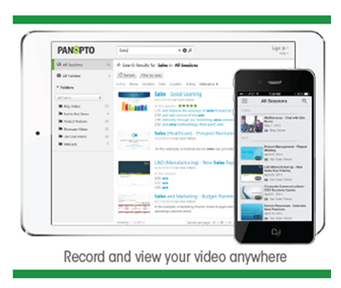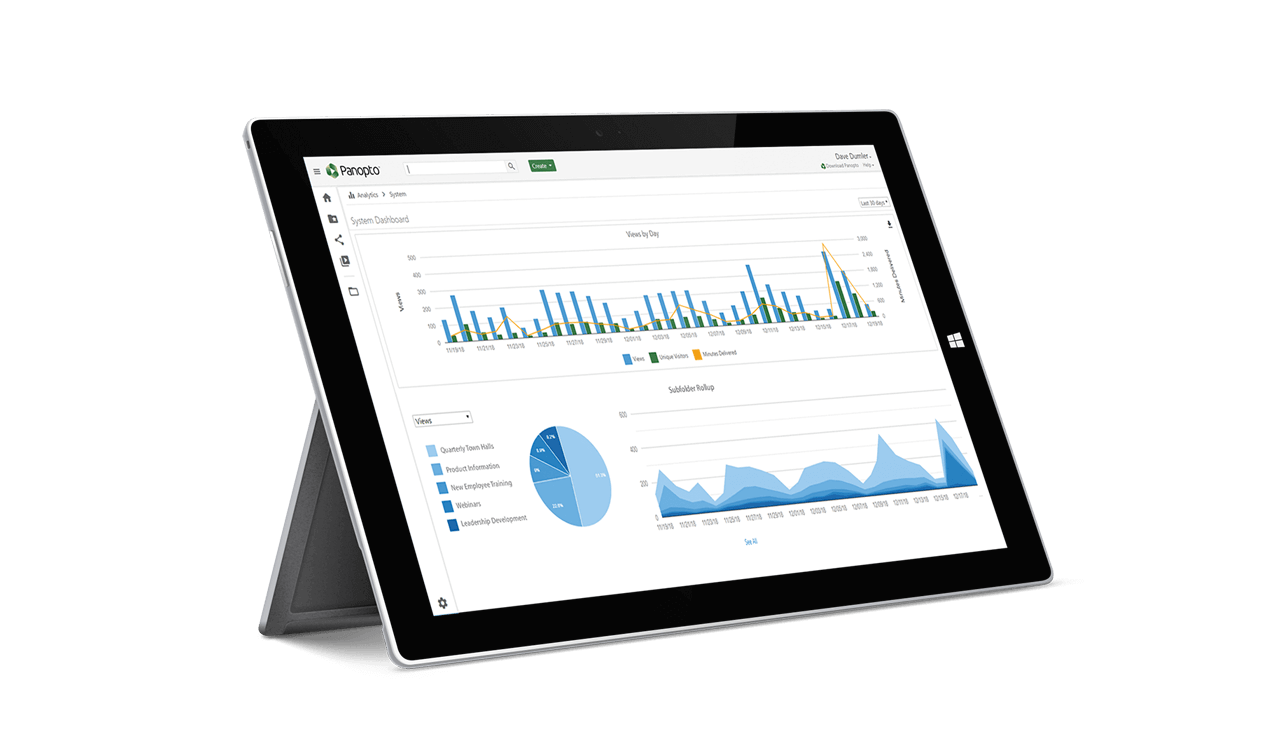- Communications
5 Video Platform Technologies That Make It Easier To Use Video for Training

Video has always offered great potential to support and scale your employee training programs, but traditional video technologies offered only point solutions that would separately record, edit, manage, and share your videos, and that were each complex and expensive to use.
Fortunately, there’s a better way now.
Modern video platforms (sometimes called video libraries, video content management systems, or simply a “corporate YouTube”) can support video from end to end — offering the ability to capture, edit, manage, search, share, and view video using an integrated suite of tools.
And while cost used to prohibit the use of enterprise video technologies outside of the top Fortune 100 companies, today a video platform can be more efficiently sourced, with affordable options for both hosted and on-premises deployments. IBM and Microsoft both reported their investments in video generated triple-digit positive ROIs, each in fewer than 2 years, and both largely due to savings on training costs.
Video platforms enable organizations to do more new things with video and get more value out of existing video content. In order to make sure your learning and development organization gets the most out of video, here are the five capabilities you’ll want to ensure your video platform includes as part of the core offering:
1. Video Search That Indexes the Actual Content In Your Video
Search is a new capability for video — and is quickly becoming a video platform’s most essential feature. As Forrester analyst Phil Karcher notes, “If it’s worth saving, it’s worth finding.”
Historically this has been a challenge for video, as many video solutions offer only limited ability to search via manually added metadata like titles or tags. And the challenge continued even when an employee actually found a video — with many training videos running 30-60 minutes or longer, the only means to find a relevant 2-minute segment was to hunt-and-peck through the entire timeline.
Modern video platforms offer a better option. Features like automatic speech recognition (ASR), optical character recognition (OCR), and slide content ingestion enable some video platforms to index a significant amount of the content spoken or shown in your recordings. By nature, training videos will be filled with details and sought out on a regular basis from employees across the organization, so strong video search capabilities are a necessity. Look for a modern platform that allows your team to search across all the videos in your library as well as inside the actual contents of each video. Specifically, the video platform should support indexing the words spoken or appearing on-screen in each video along with more traditional metadata.
See Panopto’s video search technology in action below:
2. Simple, Flexible Video Recording Options
The single most essential aspect of using video for training is also the most straightforward: you need to be able to record it, quickly, and ideally from anywhere.

When it comes to training, video is only as effective as your recording technology allows it to be.
Your video solution should be able to record with whatever camera your team and your employees use, or record their screen, or their mobile device, and do so whenever and wherever the employee chooses. Restricting employees to dedicated recorders or dedicated studio rooms only creates hurdles to adoption and may ultimately limit your success.
An ideal video solution should allow your team to capture an unlimited number of video sources, including one or many streams from webcams, camcorders, or other video cameras; video from mobile devices or wearable technologies; and the contents of one or multiple computer screens. The more recording options your system enables, the more ways you’ll find to implement video to scale and support your training programs.
3. A Mobile-Ready Video Platform Available On Any Device
 Perhaps the single most valuable aspect of using video to support your training efforts is that video enables your team to consume training content anytime, anywhere it fits into their schedules. That is if you let them.
Perhaps the single most valuable aspect of using video to support your training efforts is that video enables your team to consume training content anytime, anywhere it fits into their schedules. That is if you let them.
As more organizations move to a Bring Your Own Device model, enabling employees to use personal technology to be more productive at work, your video solution must be ready to accommodate a wide variety of devices. A mobile-ready video platform allows employees to view videos on any device regardless of the original recording format.
Ideally, your solution should offer native apps that allow users to interact with your video library just as they would from a desktop browser, complete with search, sharing, recording, and upload support along with viewing capabilities.
4. Compile Video Viewing Analytics
An important part of monitoring the success of a training program is monitoring when, how and how completely employees interact with your video. A modern video platform enables managers and administrators to do just that.
As employees log in to watch your content, viewing video analytics gives you valuable insight into what videos are being watched, and whether any given member of the team has completed any particular video. This, in turn, enables your training team to monitor compliance rates, as well as refine and revise your training programs as needed to ensure ongoing success.

5. Build A Secure Corporate Video Library
The foundational technology that enables all the above is so simple it can often be overlooked — a centralized place where your organization can store and access its video content.
 Too often, for organizations without a video library, that recording is simply saved to a hard drive, a network file share, or a SharePoint site where it’s nearly impossible for others in the company to discover. In those cases, even when the file is found, it can only be played back if the viewer happens to have a device that can play that specific file type.
Too often, for organizations without a video library, that recording is simply saved to a hard drive, a network file share, or a SharePoint site where it’s nearly impossible for others in the company to discover. In those cases, even when the file is found, it can only be played back if the viewer happens to have a device that can play that specific file type.
Of equal concern is security. Organizations that lack video content management options may find that employees already comfortable with consumer tools like YouTube or DropBox may be choosing to use these public spaces to share internal content in the name of efficiency. Ensuring your video and file systems are easy to find and easy to use with a mobile device can mitigate many unintentional security lapses.
Modern video platforms address these issues head-on, providing centralized video libraries that make sharing easy by providing a single point for file storage. As Forrester Research notes, “While content management is a less-pressing issue for organizations producing very little video, this discipline will be critical as video content production starts to expand dramatically.”
Video helps companies increase the effectiveness of their training, improve the consistency of learning content, scale L&D efforts to a global workforce, enable social knowledge sharing, and of course, lower costs. For corporate learning and development, a video platform is more than a nice-to-have — it’s a necessity.
As organizations make video a core part of their L&D efforts, the use cases outlined in this paper offer only a starting point. Training departments, management, and individual employees will discover new scenarios for using video that address the unique needs of their business and provide them with new ways to communicate and share information.
Best of all, video is no longer an inaccessible technology locked away in AV team closets and server racks. The widespread availability of inexpensive, high-quality video cameras in laptops, tablets, and smartphones — and the increasing use of video platforms are making it easier for L&D teams to do more with video.
Find Out More About Using Video For Training
![]() In our white paper, 14 Ways To Use Video For Formal and Informal Learning, we help L&D practitioners make the business case for doing more with video, including:
In our white paper, 14 Ways To Use Video For Formal and Informal Learning, we help L&D practitioners make the business case for doing more with video, including:
- 5 benefits that help convince your decision makers to use video in more ways for L&D
- 14 ideas for supporting and scaling formal and informal learning with video
- 1 technology — the video platform — that simplifies the use of video for L&D
Today’s learning and development professionals already understand the potential that video technology offers. Make sure your organization isn’t missing out!



